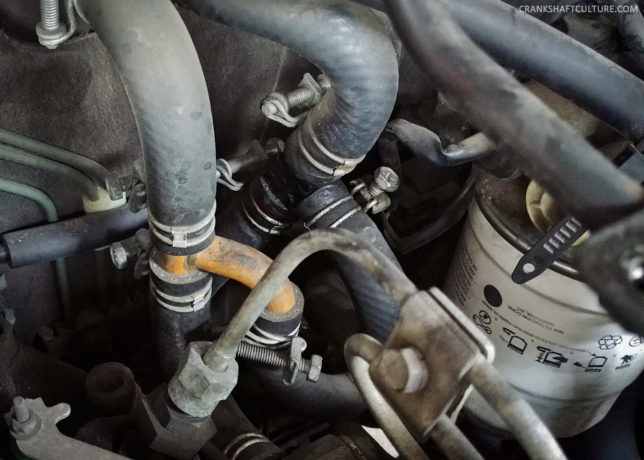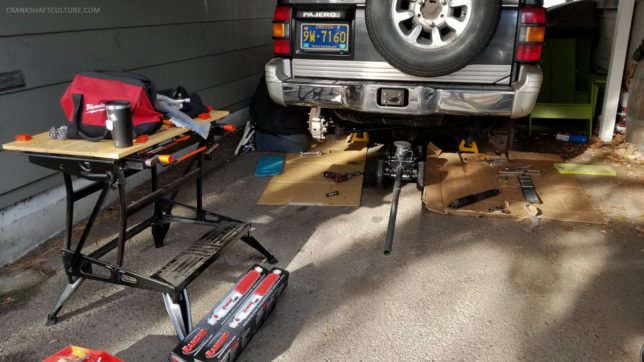Back in November, 2018 we flew to Texas for the second time in 12 months to pick up yet another second-generation Mitsubishi Pajero. We drove it back from Austin without incident, but we’ve had to put some work into the rig since.
Truth be told, we picked up this ultra-clean ’91 XP trim level Pajero for a song; it was a great deal. We knew it’d need a few things, but it ended up needing more than we anticipated.
The previous owner said the vehicle had a new clutch—he had receipts and everything. The clutch operation seemed totally normal during our test drive and didn’t raise any red flags. However, once we were well into our Texas-to-Oregon road trip, I noticed the clutch felt like it was slipping at highway speeds when you’ve give it throttle. More on that in a minute.

The previous owner also disclosed the vehicle had a slight leak at the oil pump. We took a look at the engine when in Texas, and it looked very clean—no sign of a leak near the oil pump. When we got the rig home, I noticed a couple of things. There was minor leaking coming from a joint at the heater core (no biggie), but more troublesome was a wet diesel injection pump and a very noticeable aroma of eau de diesel. It quickly dawned on me: it didn’t have an oil leak, it had a diesel leak.
Remember that old childhood game of “telephone” where someone at the front of the line says a phrase and it gets passed down from person to person until it reaches the front of the line? Often times the final message gets jumbled from the original. I’m guessing that’s similar to what happened here. It wasn’t the oil pump that had a leak, it was the injection pump.
We brought the Paj into Dean’s Car Care in Portland, which is a local expert on the Mitsubishi 4D56 engine, to have a timing belt, water pump, and thermostat changed out. We also had Dean and crew send the injection pump out to be rebuilt and reinstalled. While fairly priced, it still wasn’t cheap. Thankfully, since we got such a good deal on the rig in the first place, the maintenance costs didn’t sting quite as badly. A week later, our Pajero was equipped with many new parts including that rebuilt injection pump. They did a good job on everything, and unfortunately confirmed the clutch was indeed slipping.
So the clutch was going to need to be replaced. I ended up ordering the necessary clutch parts from KS International LTD in the UK. The parts arrived in under five days (which is still incredible to me, since it takes five days to send my mom a postcard, and she lives in Wisconsin). Clutch housing, disc, master cylinder, pilot bearing—the works. Good prices, too.
Clutch Situation
Back into the shop went our ’91 Pajero. This time we dropped the Paj off with our friend and mechanic, Mark Hatten, of MPH Specialties. He works on all sorts of oddball vehicles, and has worked on all of our other right-hand drive JDM vehicles in the past. As he tore into the clutch, he confirmed the clutch components had indeed been replaced recently and the flywheel had been machined. However, he said the flywheel was slick with oil. Immediately my mind went to some sort of horrible oil leak that was going to cost even more cash. Mark explained that it appeared the shop in Texas which replaced the clutch the first time never bothered to clean the flywheel of oil/grease, likely after it was machined. This left it slippery and never allowed the clutch to grab on leading to premature failure. This one little action—not cleaning the flywheel before installing the clutch—likely cost us a bunch of money, and a new clutch. How maddening!
Anyhow, Mark at MPH found a few other things that needed attention, namely a shifter bushing (which should hopefully cure the floppy side-to-side shifter action) and a totally worn transfer case mount. This is why we bring our rigs to Mark. But it is what it is, and now we know it’ll be done right. In fact, here’s a little video Mark put together for his popularYouTube channel.
Beware the ‘FPO’
This isn’t the first time we’ve had to tidy up after someone else’s motoring mistakes, by the way. (See my rant on our sister site, Subcompact Culture.) It also reminds me of when I first started to look for a Montero; back before we picked up our 1992 Pajero, aka the Ralli Tractor. I had asked in the Mitsubishi Montero USA Facebook group if there were certain things I should be on the lookout for when shopping for a used Montero. Someone simply replied “Yeah. The FPO.” I kept thinking to myself, what does FPO stand for in the automotive world? I searched Google and couldn’t find anything. Finally, feeling like a total newbie who didn’t know a thing about cars or trucks, I asked, “What’s an FPO?” They replied, “the Fucking Previous Owner.” So true. In this case, it wasn’t so much the FPO; quite the contrary. It was the previous owner’s f’ing mechanic. Unlike many old Mitsubishis, the previous owner of our ’91 Pajero actually kept this one in good shape. You should still beware.

Our work on the Pajero hasn’t been all maintenance, however. Like the 1992, we equipped our ’91 with Rancho RS9000XL shock absorbers at all four corners, and lifted the rear using long wheelbase Montero springs; the front got cranked-up torsion bars. In fact, you can read Mercedes’ write-up on the whole thing on Drivingline.com.
Future Upgrades
We’ve got a few other tricks coming for our second Pajero. This includes items like 16×8 wheels, 285/75/16 tires, a winch bumper, winch, auxiliary LED lights, and more. So stay tuned as Pajero 2 gets its the full treatment.

Andy Lilienthal is an award-winning writer and has written professionally since 1999. He has over 13 years in the automotive aftermarket working at companies including Warn Industries, Bushwacker, and Lund International. Editorial works include writing and photography for off-road print magazines, to new-car reviews online. He’s a photographer with images in multiple magazines, blog sites, and The New York Times.


Leave a Reply